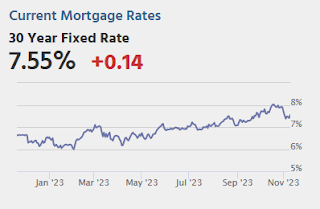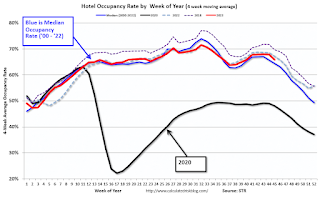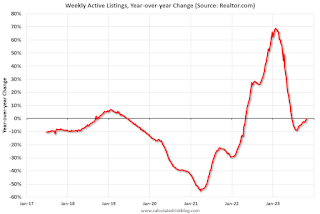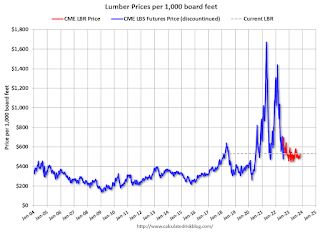by Calculated Risk on 11/10/2023 11:21:00 AM
Friday, November 10, 2023
2nd Look at Local Housing Markets in October
Today, in the Calculated Risk Real Estate Newsletter: 2nd Look at Local Housing Markets in October
A brief excerpt:
NOTE: Starting next month, I’ll add some comparisons to 2019 (pre-pandemic)!There is much more in the article. You can subscribe at https://calculatedrisk.substack.com/
This is the second look at several early reporting local markets in October. I’m tracking about 40 local housing markets in the US. Some of the 40 markets are states, and some are metropolitan areas. I’ll update these tables throughout the month as additional data is released.
Closed sales in October were mostly for contracts signed in August and September. Since 30-year fixed mortgage rates were in the 7.1% in August and 7.2% in September, compared to the high-5% range the previous year, closed sales were down year-over-year in October.
...
In October, sales in these markets were down 10.3%. In September, these same markets were down 18.8% YoY Not Seasonally Adjusted (NSA).
This is a much smaller YoY decline NSA than in September for these early reporting markets. However, this is where seasonal adjustments make a difference.
There was one more working day in October 2023 compared to October 2022, the opposite of September when there was one fewer working day in 2023 compared to 2022. So, for October, the seasonally adjusted decline will be larger than the NSA decline.
...
This early data suggests the October existing home sales report will show another significant YoY decline, perhaps to just above 4 million SAAR (early guess of Seasonally Adjusted Annual Rate), and above the cycle low of 3.96 million SAAR last month. This will be the 26th consecutive month with a YoY decline in sales.
...
Many more local markets to come!
Q4 GDP Tracking: Starting Close to 2%
by Calculated Risk on 11/10/2023 08:40:00 AM
From BofA:
Overall, data since our last weekly publication pushed up our 3Q US GDP tracking estimate from 5.1% q/q saar to 5.2% q/q saar. [W]e will start our 4Q US GDP tracker with the retail sales print [Nov 10th]From Goldman:
emphasis added
We boosted our past-quarter GDP tracking estimate for Q3 to +5.2% and left our Q4 GDP tracking estimate unchanged at +1.6%. [Nov 8th estimate]And from the Altanta Fed: GDPNow
The GDPNow model estimate for real GDP growth (seasonally adjusted annual rate) in the fourth quarter of 2023 is 2.1 percent on November 8, unchanged from November 7 after rounding. [Nov 8th estimate]
Thursday, November 09, 2023
Friday: Veterans Day
by Calculated Risk on 11/09/2023 08:10:00 PM

Friday:
• Veterans Day Holiday: Most banks will be closed in observance of Veterans Day. The stock market will be open.
• At 10:00 AM ET, University of Michigan's Consumer sentiment index (Preliminary for November).
Part 1: Current State of the Housing Market; Overview for mid-November
by Calculated Risk on 11/09/2023 03:39:00 PM
Today, in the Calculated Risk Real Estate Newsletter: Part 1: Current State of the Housing Market; Overview for mid-November
A brief excerpt:
The NAR reported sales were at a “seasonally adjusted annual rate of 3.96 million in September. Year-over-year, sales dropped 15.4% (down from 4.68 million in September 2022).” This was in line with the local markets I tracked for September.There is much more in the article. You can subscribe at https://calculatedrisk.substack.com/
This was a new cycle low for existing home sales.
Usually, house prices bottom after sales bottom, so a new cycle low for sales suggests likely further weakness for house prices in coming months. I’ll have more on this pattern.
Census: U.S. Population Projected to Begin Declining in Second Half of Century
by Calculated Risk on 11/09/2023 03:07:00 PM
I'll have much more on these projections - and the implications for housing - soon (I'm sure housing economist Tom Lawler will comment!)
From Census: U.S. Population Projected to Begin Declining in Second Half of Century
The U.S. population is projected to reach a high of nearly 370 million in 2080 before edging downward to 366 million in 2100. By 2100, the total U.S. resident population is only projected to increase 9.7% from 2022, according to the latest U.S. Census Bureau population projections released today. The projections provide possible scenarios of population change for the nation through the end of the century.
...
“In an ever-changing world, understanding population dynamics is crucial for shaping policies and planning resources,” stated Sandra Johnson, a demographer at the Census Bureau.
“The U.S. has experienced notable shifts in the components of population change over the last five years,” she explained. “Some of these, like the increases in mortality caused by the COVID-19 pandemic, are expected to be short-term while others, including the declines in fertility that have persisted for decades, are likely to continue into the future. Incorporating additional years of data on births, deaths and international migration into our projections process resulted in a slower pace of population growth through 2060 than was previously projected.”
Projections illustrate possible courses of population change based on assumptions about future births, deaths and net international migration. The 2023 projections include a main series (also known as the middle series) considered the most likely outcome of four assumptions, and three alternative immigration scenarios that show how the population might change under high, low and zero immigration assumptions.
 Click on graph for larger image.
Click on graph for larger image.This graph shows the projected US population for the four series.
From Census:
By 2100, the total population in the middle series is projected to reach 366 million compared to the projection for the high-immigration scenario, which puts the population at 435 million. The population for the middle series increases to a peak at 370 million in 2080 and then begins to decline, dropping to 366 million in 2100. The high-immigration scenario increases every year and is projected to reach 435 million by 2100.
The low-immigration scenario is projected to peak at around 346 million in 2043 and decline thereafter, dropping to 319 million in 2100.
Though largely illustrative, the zero-immigration scenario projects that population declines would start in 2024 in the complete absence of foreign-born immigration. The population in this scenario is projected to be 226 million in 2100, roughly 107 million lower than the 2022 estimate.
Hotels: Occupancy Rate Decreased 4.0% Year-over-year
by Calculated Risk on 11/09/2023 01:33:00 PM
U.S. hotel performance showed an expected decline from the previous week as well as mixed year-over-year comparisons, according to CoStar’s latest data through 4 November.The following graph shows the seasonal pattern for the hotel occupancy rate using the four-week average.
29 October through 4 November 2023 (percentage change from comparable week in 2022):
• Occupancy: 59.7% (-4.0%)
• Average daily rate (ADR): US$152.90 (+2.0%)
• Revenue per available room (RevPAR): US$91.23 (-2.1%)
The decrease in occupancy was anticipated with Halloween falling on Tuesday.
emphasis added
 Click on graph for larger image.
Click on graph for larger image.The red line is for 2023, black is 2020, blue is the median, and dashed light blue is for 2022. Dashed purple is for 2018, the record year for hotel occupancy.
Realtor.com Reports Weekly New Listings UP 0.6% YoY; Active Inventory Down Only 0.2% YoY
by Calculated Risk on 11/09/2023 09:35:00 AM
Realtor.com has monthly and weekly data on the existing home market. Here is their weekly report: Weekly Housing Trends View — Data Week Ending Nov 4, 2023
• Active inventory declined slightly, with for-sale homes lagging behind year ago levels by 0.2%. For 20 straight weeks, the number of homes available for sale has registered below that of the previous year, though by just a small margin this week.
• New listings–a measure of sellers putting homes up for sale–were up this week, by 0.6% from one year ago. Since mid-2022, new listings have registered lower than prior year levels, as the mortgage rate lock-in effect freezes homeowners with low-rate existing mortgages in place. Over the last two weeks, however, the trend has reversed as new listings during the week outpaced the same week in the previous year by 0.6%, smaller than the previous week’s spike. This week’s stabilization comes after a spike last week, falling more in line with the shrinking gap in new listings over the last few months. With the number of homes for sale already limited, a lack of growth in new listings is likely to continue to weigh on existing home sales in the months ahead.
 Here is a graph of the year-over-year change in inventory according to realtor.com.
Here is a graph of the year-over-year change in inventory according to realtor.com. Inventory was down 0.2% year-over-year - this was the 20th consecutive week with a YoY decrease following 58 consecutive weeks with a YoY increase in inventory.
Weekly Initial Unemployment Claims Decrease to 217,000
by Calculated Risk on 11/09/2023 08:30:00 AM
The DOL reported:
In the week ending November 4, the advance figure for seasonally adjusted initial claims was 217,000, a decrease of 3,000 from the previous week's revised level. The previous week's level was revised up by 3,000 from 217,000 to 220,000. The 4-week moving average was 212,250, an increase of 1,500 from the previous week's revised average. The previous week's average was revised up by 750 from 210,000 to 210,750.The following graph shows the 4-week moving average of weekly claims since 1971.
emphasis added
 Click on graph for larger image.
Click on graph for larger image.The dashed line on the graph is the current 4-week average. The four-week average of weekly unemployment claims increased to 212,250.
The previous week was revised up.
Weekly claims were sligthly lower than the consensus forecast.
Wednesday, November 08, 2023
Thursday: Unemployment Claims
by Calculated Risk on 11/08/2023 07:40:00 PM

Thursday:
• At 8:30 AM ET, The initial weekly unemployment claims report will be released. The consensus is for 221 thousand initial claims, up from 217 thousand last week.
Update: Lumber Prices Down Slightly YoY
by Calculated Risk on 11/08/2023 02:25:00 PM
This graph shows CME random length framing futures through last August (blue), and the new physically-delivered Lumber Futures (LBR) contract starting in August 2022 (Red).



